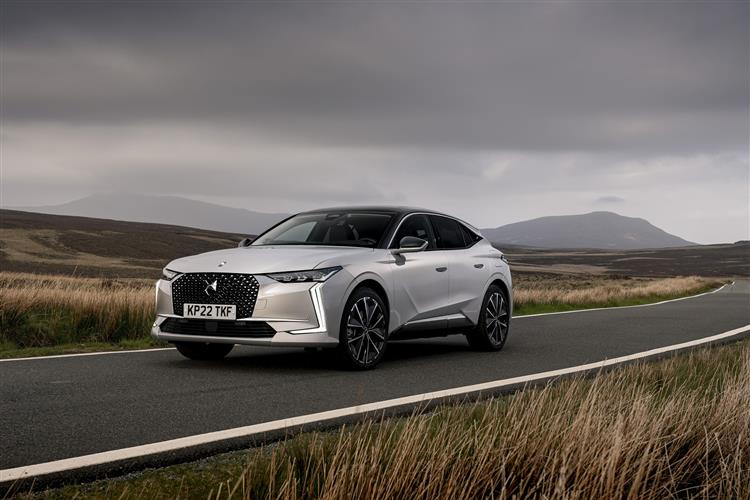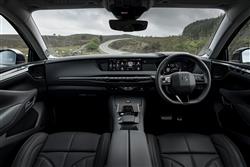PRESENT TENSE (some text hidden) --NONE--
By Jonathan Crouch
The DS 4 is at its most sophisticated in E-TENSE 225 Plug-in Hybrid form. Jonathan Crouch drives it.
Ten Second Reviewword count: 48
DS makes quite a speciality out of its E-TENSE Plug-in Hybrid models - here's another of them, the avant garde-looking DS 4 E-TENSE 225 compact premium hatch. It's ambitiously priced but you get a super-sized dose of style for the outlay and drive technology that's really cutting edge.
Backgroundword count: 120
The idea of having Plug-in Hybrid tech in your next family hatch is tempting. But if the car you have in mind is a mainstream brand PHEV model, the prospect of paying well over £40,000 for it might not be. You probably won't be far off that by the time you properly spec up a PHEV Peugeot 308, Vauxhall Astra or Volkswagen Golf. You'd feel a lot better though, splashing out this kind of sum if the car in question had a premium badge and a much more up-market feel. Such is the appeal of models like the Audi A3 Sportback 40 TFSIe and the Mercedes A250e. And of the car we look at here, the DS 4 E-TENSE 225.
Driving Experienceword count: 310
The DS 4 E-TENSE Plug-in Hybrid model uses a familiar Peugeot / Citroen-derived 1.6-litre PureTech petrol unit mated to a 108bhp electric motor powered by a 12.4kWh battery for a combined output of 225hp and an electric driving range of up to 38.5 miles. There are two additional drive modes available with this PHEV variant - self-explanatory 'Hybrid' and 'Electric': and if you shift into 'Sport', there's a reasonable turn of speed that sees 62mph dispatched in 7.7s en route to 145mph. That's despite the E-TENSE model's extra 200kgs of weight over its conventional counterparts (which you rather feel when throwing the car into a corner in a way a likely owner probably never would). A full-electric variant will eventually arrive too, sharing its 50kWh battery and 250 mile driving range with the Peugeot e-308. So everything beneath the bonnet we've seen before - and the EMP2 chassis it all sits on is very familiar too, though the French maker claims 70% of that platform has been modified to meet various specific DS 4 requirements - one of those being the need to accommodate the particularly large 20-inch wheels of top variants. These are detail differences, but a little more substance lies with the addition of certain high-tech drive electronics which, for the time being, DS has reserved for itself. Chief amongst these is the clever Active Scan Suspension system which uses a camera that looks ahead across the tarmac as you drive, over a distance of between 5 and 25-metres, altering damping predictively. It only operates in the 'Comfort' drive mode and doesn't work quite as effectively as you might hope it would - you still crash over speed humps for example - but the set-up restores a modicum of ride subtlety, though in a rather wafty way that makes you feel a bit disconnected from the whole experience.
To see the full road test text contact us on 0330 0020 227
Pictures (high res disabled)

.jpg)
|
.jpg)
|
.jpg)
| |||
.jpg)
|
.jpg)
|
.jpg)
| |||
.jpg)
|
.jpg)
|

|
Statistics (subset of data only)
Min |
Max |
|
Price: |
£40,910.00 (At 16 May 2024) |
£47,210.00 (At 16 May 2024) |
Insurance group 1-50: |
30 |
|
CO2 (g/km): |
27 |
|
Max Speed (mph): |
145 |
|
0-62 mph (s): |
7.7 |
|
Electric WLTP-Rated Driving Range (miles): |
38 |
|
Length (mm): |
4440 |
|
Width (mm): |
1830 |
|
Height (mm): |
1470 |
|
Boot Capacity (l): |
390 |
|
Scoring (subset of scores)
Category: Hybrid, Plug-in, Electric & Hydrogen
| Performance | |
| Handling | |
| Comfort | |
| Space | |
| Styling, Build, Value, Equipment, Depreciation, Handling, Insurance and Total scores are available with our full data feed. | |



